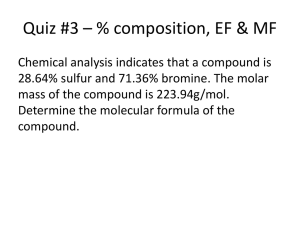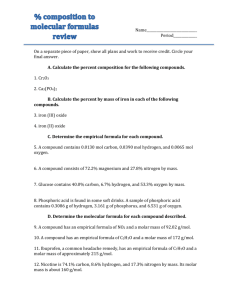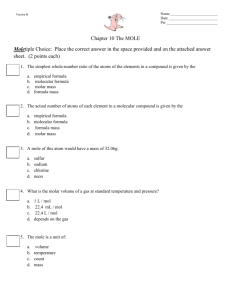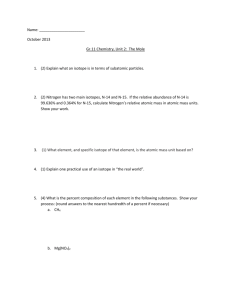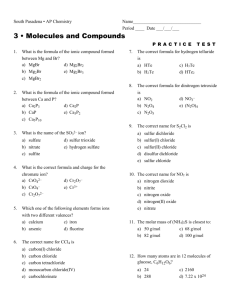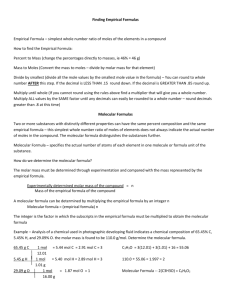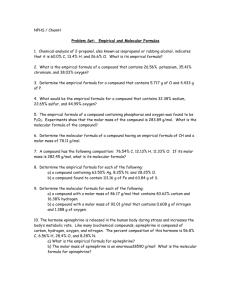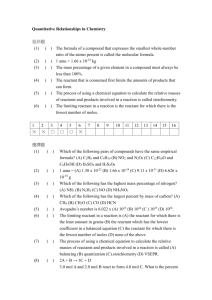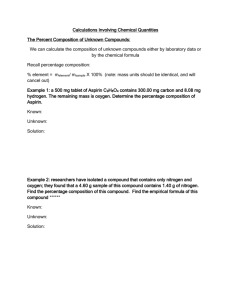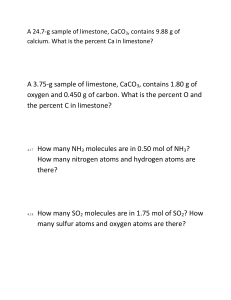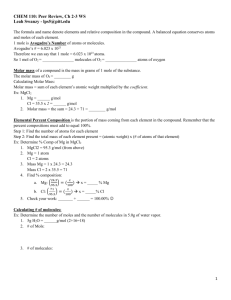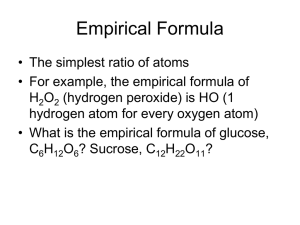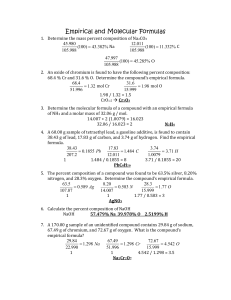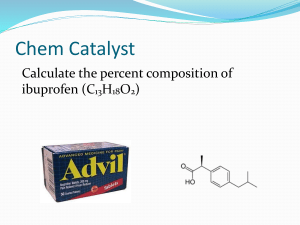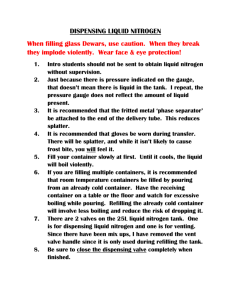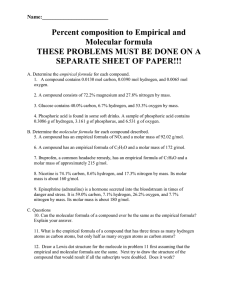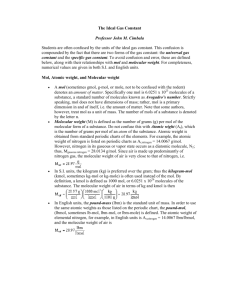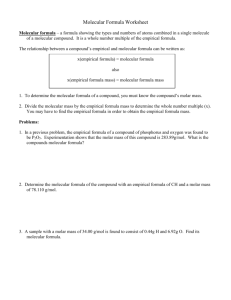Empirical Formula and Gas Law Homework You must show all of the
advertisement
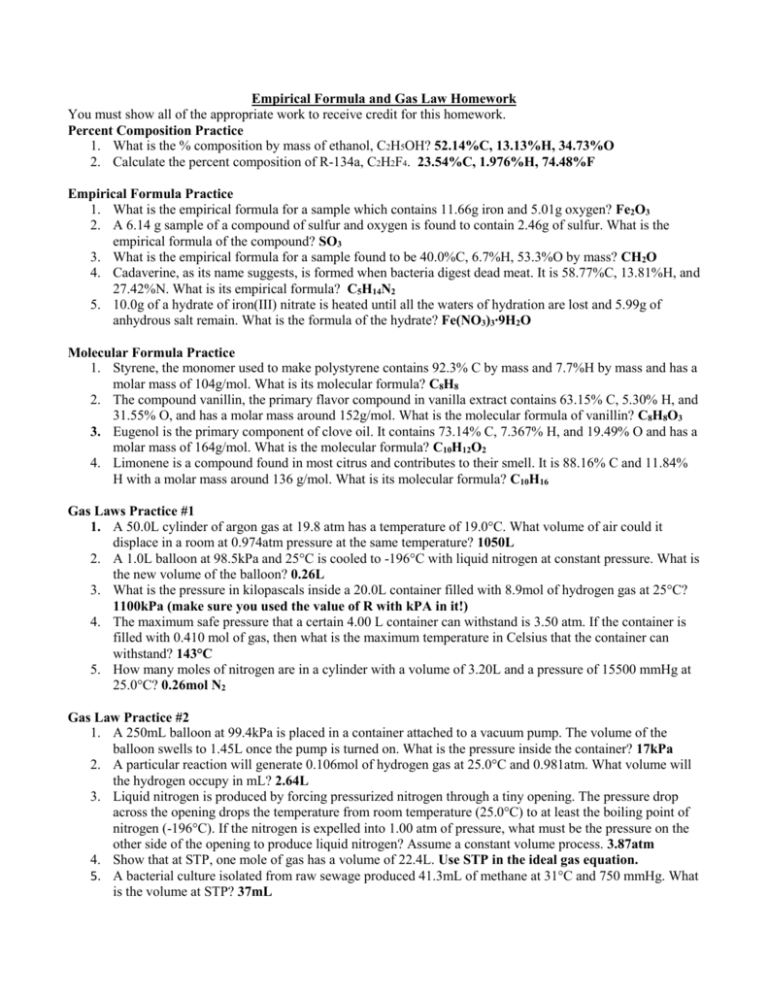
Empirical Formula and Gas Law Homework You must show all of the appropriate work to receive credit for this homework. Percent Composition Practice 1. What is the % composition by mass of ethanol, C2H5OH? 52.14%C, 13.13%H, 34.73%O 2. Calculate the percent composition of R-134a, C2H2F4. 23.54%C, 1.976%H, 74.48%F Empirical Formula Practice 1. What is the empirical formula for a sample which contains 11.66g iron and 5.01g oxygen? Fe2O3 2. A 6.14 g sample of a compound of sulfur and oxygen is found to contain 2.46g of sulfur. What is the empirical formula of the compound? SO3 3. What is the empirical formula for a sample found to be 40.0%C, 6.7%H, 53.3%O by mass? CH2O 4. Cadaverine, as its name suggests, is formed when bacteria digest dead meat. It is 58.77%C, 13.81%H, and 27.42%N. What is its empirical formula? C5H14N2 5. 10.0g of a hydrate of iron(III) nitrate is heated until all the waters of hydration are lost and 5.99g of anhydrous salt remain. What is the formula of the hydrate? Fe(NO3)3∙9H2O Molecular Formula Practice 1. Styrene, the monomer used to make polystyrene contains 92.3% C by mass and 7.7%H by mass and has a molar mass of 104g/mol. What is its molecular formula? C8H8 2. The compound vanillin, the primary flavor compound in vanilla extract contains 63.15% C, 5.30% H, and 31.55% O, and has a molar mass around 152g/mol. What is the molecular formula of vanillin? C8H8O3 3. Eugenol is the primary component of clove oil. It contains 73.14% C, 7.367% H, and 19.49% O and has a molar mass of 164g/mol. What is the molecular formula? C10H12O2 4. Limonene is a compound found in most citrus and contributes to their smell. It is 88.16% C and 11.84% H with a molar mass around 136 g/mol. What is its molecular formula? C10H16 Gas Laws Practice #1 1. A 50.0L cylinder of argon gas at 19.8 atm has a temperature of 19.0°C. What volume of air could it displace in a room at 0.974atm pressure at the same temperature? 1050L 2. A 1.0L balloon at 98.5kPa and 25°C is cooled to -196°C with liquid nitrogen at constant pressure. What is the new volume of the balloon? 0.26L 3. What is the pressure in kilopascals inside a 20.0L container filled with 8.9mol of hydrogen gas at 25°C? 1100kPa (make sure you used the value of R with kPA in it!) 4. The maximum safe pressure that a certain 4.00 L container can withstand is 3.50 atm. If the container is filled with 0.410 mol of gas, then what is the maximum temperature in Celsius that the container can withstand? 143°C 5. How many moles of nitrogen are in a cylinder with a volume of 3.20L and a pressure of 15500 mmHg at 25.0°C? 0.26mol N2 Gas Law Practice #2 1. A 250mL balloon at 99.4kPa is placed in a container attached to a vacuum pump. The volume of the balloon swells to 1.45L once the pump is turned on. What is the pressure inside the container? 17kPa 2. A particular reaction will generate 0.106mol of hydrogen gas at 25.0°C and 0.981atm. What volume will the hydrogen occupy in mL? 2.64L 3. Liquid nitrogen is produced by forcing pressurized nitrogen through a tiny opening. The pressure drop across the opening drops the temperature from room temperature (25.0°C) to at least the boiling point of nitrogen (-196°C). If the nitrogen is expelled into 1.00 atm of pressure, what must be the pressure on the other side of the opening to produce liquid nitrogen? Assume a constant volume process. 3.87atm 4. Show that at STP, one mole of gas has a volume of 22.4L. Use STP in the ideal gas equation. 5. A bacterial culture isolated from raw sewage produced 41.3mL of methane at 31°C and 750 mmHg. What is the volume at STP? 37mL


